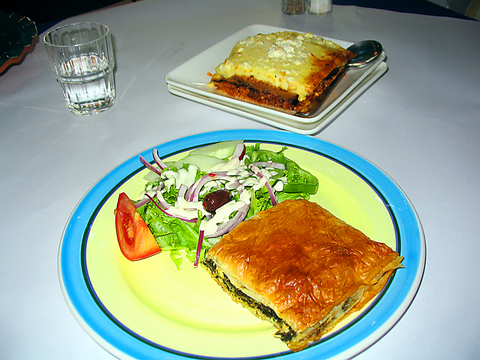Mykonos, in the middle of the Aegean Sea, is one of the most popular of the Greek isles. It is also the namesake of one of Taipei's favorite foreign eateries, which reopened in its fourth
incarnation just a few months ago.
I'm happy to be able to report that Mykonos has made the move from Lishui Street to Siwei Road (just off of Da'an Road above Xinyi Road) without losing any of its key ingredients -- good food and ambiance.

PHOTO: DIANE BAKER, TAIPEI TIMES
When Mike Waldorf and his partner Gino Lin decided to open a restaurant in Taipei more than a decade ago, Waldorf decided to feature Greek food because of the interest he had developed in it years before when he worked on the big cruise liners plying the Mediterranean.
From the beginning, Mykonos' whitewashed walls and blue trim evoked postcard images of sun-drenched seaside villages. The music of Nana Mouskouri and Greek instrumentals in the background also helped.
A good way to start off a meal with friends at Mykonos is by choosing the combination meza plate, which offers a sampling of some of the cafe's appetizers -- hummus, tzaziki, feta cheese and greek olives, yogurt and an eggplant dip -- served with slices of pita bread, all for NT$400. Individual choices for appetizers range from NT$220 to NT$280 and include marinated mushrooms, taramasalata and htipiti, which is a spicy feta cheese spread.
Favorite entrees for my friends include kotopoulo psito, which is half a roast chicken, for NT$530 and grilled salmon for NT$520. The entree sets are good value as they include soup, salad and coffee or tea. Other favorites are gyro pita, slices of roasted lamb served on pita bread, which is NT$350, as is the moussaka, a crustless pie combining minced lamb, thin slices of eggplant, tomatoes and spices.
A friend and I couldn't decide between the spanakotiropita, the cheese and spinach pie, or the meatless version of the moussaka, which is made from eggplant, rice, thin slices of potatoes, raisins, pine nuts and spices. So we decided to order both and split them. The spanakotiropita was just as delicious as we had remembered from visits to Mykonos versions I, II and III, but the generous serving of the veggie moussaka was more than we could handle.
If only the sea were right outside the cafe, life would be perfect. As it is, Mykonos is a pleasant oasis in the urban roar of Taipei.

That US assistance was a model for Taiwan’s spectacular development success was early recognized by policymakers and analysts. In a report to the US Congress for the fiscal year 1962, former President John F. Kennedy noted Taiwan’s “rapid economic growth,” was “producing a substantial net gain in living.” Kennedy had a stake in Taiwan’s achievements and the US’ official development assistance (ODA) in general: In September 1961, his entreaty to make the 1960s a “decade of development,” and an accompanying proposal for dedicated legislation to this end, had been formalized by congressional passage of the Foreign Assistance Act. Two

Despite the intense sunshine, we were hardly breaking a sweat as we cruised along the flat, dedicated bike lane, well protected from the heat by a canopy of trees. The electric assist on the bikes likely made a difference, too. Far removed from the bustle and noise of the Taichung traffic, we admired the serene rural scenery, making our way over rivers, alongside rice paddies and through pear orchards. Our route for the day covered two bike paths that connect in Fengyuan District (豐原) and are best done together. The Hou-Feng Bike Path (后豐鐵馬道) runs southward from Houli District (后里) while the

On March 13 President William Lai (賴清德) gave a national security speech noting the 20th year since the passing of China’s Anti-Secession Law (反分裂國家法) in March 2005 that laid the legal groundwork for an invasion of Taiwan. That law, and other subsequent ones, are merely political theater created by the Chinese Communist Party (CCP) to have something to point to so they can claim “we have to do it, it is the law.” The president’s speech was somber and said: “By its actions, China already satisfies the definition of a ‘foreign hostile force’ as provided in the Anti-Infiltration Act, which unlike

Mirror mirror on the wall, what’s the fairest Disney live-action remake of them all? Wait, mirror. Hold on a second. Maybe choosing from the likes of Alice in Wonderland (2010), Mulan (2020) and The Lion King (2019) isn’t such a good idea. Mirror, on second thought, what’s on Netflix? Even the most devoted fans would have to acknowledge that these have not been the most illustrious illustrations of Disney magic. At their best (Pete’s Dragon? Cinderella?) they breathe life into old classics that could use a little updating. At their worst, well, blue Will Smith. Given the rapacious rate of remakes in modern